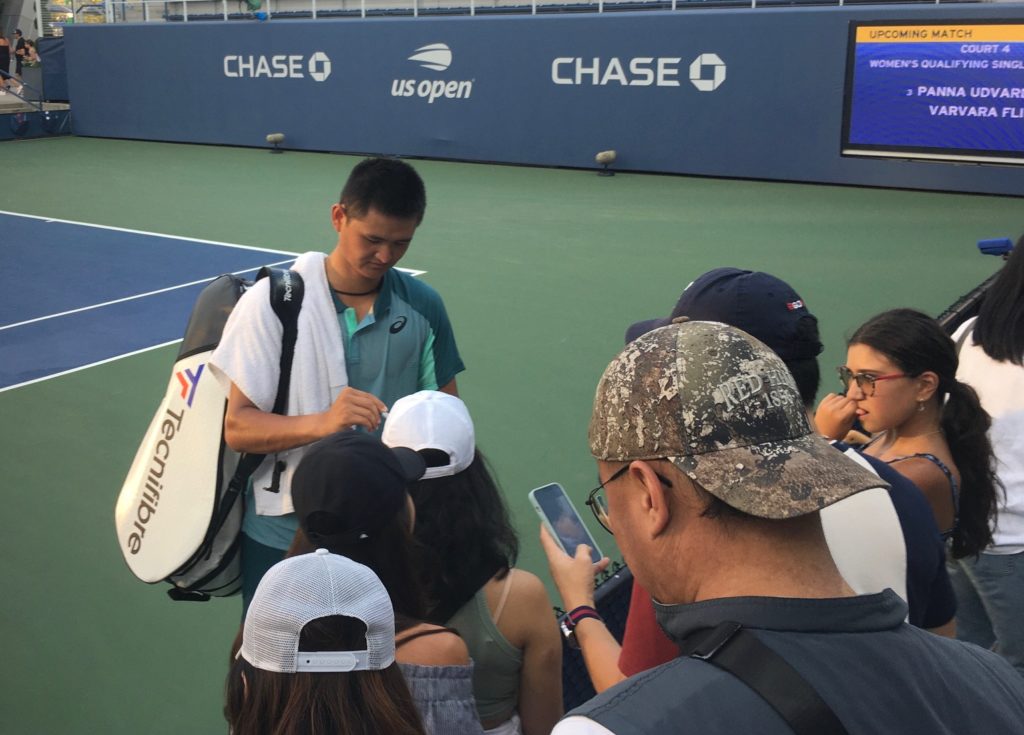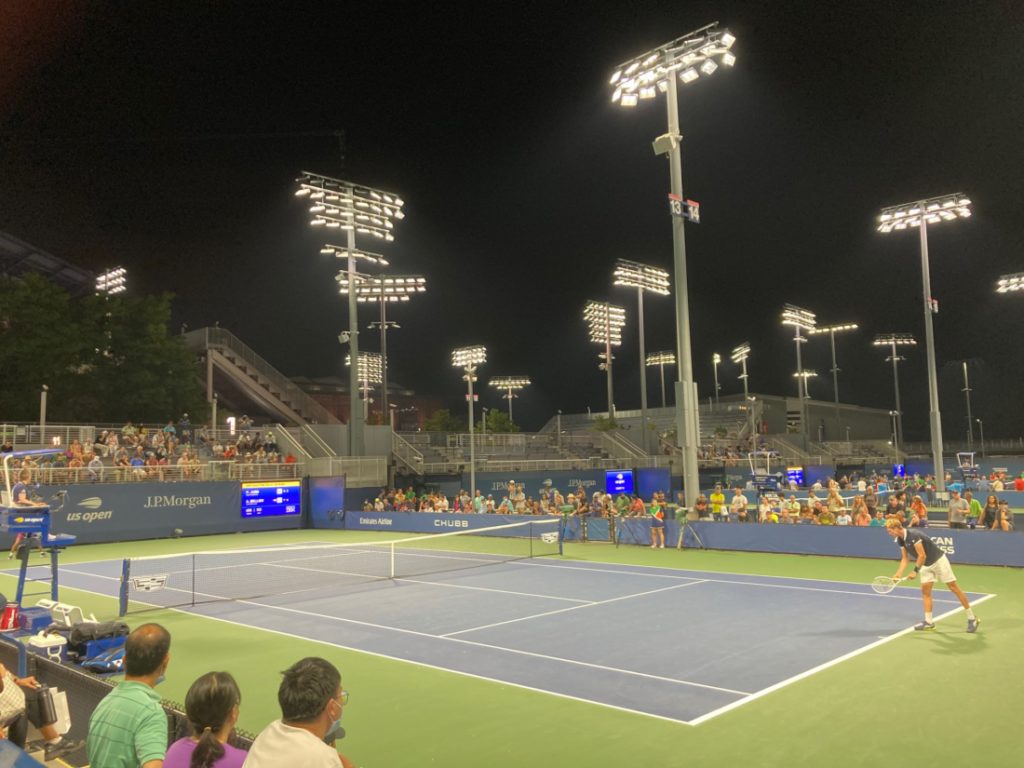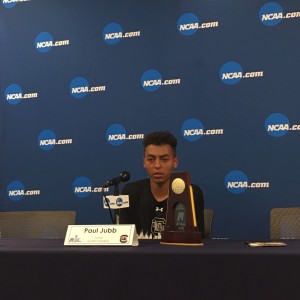By Randy Walker
@TennisPublisher
There usually is a big increase in attendance on Day Two of the U.S. Open Qualifying Tournament. Perhaps when the first day of the tournament starts, it finally gets on people’s radar, or they start to see the increase in news stories about the U.S. Open. The matches are televised, again, on ESPNews and ESPN+ and the commentators consistently remind viewers that U.S. Open Qualifying is FREE and for those that don’t already know about this amazing offering by the U.S. Tennis Association, word travels fast.
I decided to have go to the afternoon matches, as I was invited to do a radio and podcast interview at 12:30 with Ann Liguori on Serena Williams and her pending separation from pro tennis. My good friend Katia Bogomolov, now the assistant women’s tennis coach at Fordham, texted me and asked where I was on site. She was on Court 4, sitting on the shady side on the far west of the complex. I realized Court 4 might be my favorite court on the complex. It’s intimate, stuck in the corner, against the road with actually some shady by the trees that border the edge of the grounds. The match that was being played there was Facundo Bagnis of Argentina against Tung-Lin Wu of Chinese Taipei. Many Taiwanese people came out to support Wu and you could feel the extra ovations and encouragements he got after every point he won. That’s one of the great things about U.S. Open qualifying, and the U.S. Open in general, is that it is played in Queens, which is the most ethnically diverse part of the country and there are probably people there from every country in the world. The Taiwanese came out to support their man Wu. Unfortunately for them, he lost 6-4 in the third set, despite have 15-40 on the Bagnis serve in the final game. Wu still signed autographs and posed for pictures for an extended period after the loss.

There definitely is a different “culture” of fans at the U.S. Open qualifying. The demographic is certainly lower than the main draw as you can see from not-so-fancy clothing on more fans. Literally, people are walking in off the street to watch tennis. I saw a large man with a pro-wrestler’s physique with blue jeans, an open shirt exposing his entire stomach and chest and a straw cowboy hat. I don’t think that is a guy who would be sitting in the Chase Bank suite during the men’s singles final. I sat next to a chatty 11-year-old boy who said his mom drove him up from Philadelphia for the day to watch the qualifying matches. That’s a good effort! But most of these fans at the qualifying are not really tennis fans. Many don’t know the etiquette. At almost every match during qualifying, players have to wait while fans walk in and around the stands right as players are about to serve or mid-point. “Please take your seat. Any seat,” was said well over a dozen times by my ear during the five sets or so of tennis that I watched Wednesday. This is what the free U.S. Open qualifying is designed for….to bring new fans into the U.S. Open and introduce them to tennis so they will be inspired to play or watch more tennis in the future. It’s one of the best offerings, if not THE best offering, the U.S. Open has.
I was happy to see a lot of Katia’s family sitting with her, including her brother Alex, a former top 50 pro, and his 12-year-old son Maddox, who is a huge tennis fan. Years ago I gave Maddox a copy of my book “On This Day In Tennis History” and it is so exciting to me how much he loves the book and he reads it about every day. “His copy is really worn out,” Katia told me. Maddox loves to talk tennis with me and about entries in the book. I encouraged him to start to write about tennis a bit and try to become a “kid journalist” so to speak. I remember just writing about tennis for fun when I was about his age, or a few years older. It put me on the early path to an amazing career in tennis media. It was fun to reminisce with Alex (aka “Bogie”) about an amazing match he had at the U.S. Open in 2011 when he came back from two-sets-to-love down to beat NCAA singles champion Steve Johnson in the first round.
After I parted ways with the Bogomolovs, I sat in the bleachers on Court 13, also a very intimate court, to watch Paul Jubb of Great Britain play his first round qualifying match. When I went to the NCAA Championships in Lake Nona, Florida in 2019, I ran into my good friend and the author of “Tournament Tough” Carlos Goffi, who coached both John and Patrick McEnroe. Goffi was watching Jubb, who was playing in the NCAA singles tournament for his son Josh, the head coach at the University of South Carolina. “Watch this guy Randy. I’m telling you, he is going to win this tournament,” Carlos told me about Jubb. Sure enough, four rounds later, he was the NCAA singles champ.
While I was checking to see how Jubb was playing, I was immediately drawn to his opponent, a tall lanky player from Geneva, Switzerland named Antoine Bellier. He had a crafty lefty game, and chipped and charged and had amazing volleys and reflexes. I especially loved watching him play because his style of play is kind of how I play – chip and charge and come in as much as you can. “Look at this guy,” said one fan wearing red sneakers, knee socks, jogging shorts and grey T-shirt. “I’ve never seen anyone play like him before.”
Bellier is 25 years old and ranked No. 195 and Jubb is ranked a few spots lower at No. 205 and is 22 years old. Jubb has a UTR or 14.88 and Bellier is !4.19, so Jubb SHOULD win.
Bellier was up 7-5, 4-1 and seemed in control. He had several points for a double-break lead and to take a 5-1 lead, and to serve for the match, but Jubb had a huge hold after many deuces and back and forths. I wasn’t paying too close attention to the specifics as I was sending furious notes back and forth with an attractive woman on Bumble who works on Wall Street and also because I felt like Bellier was playing so well that he was going to close out the match easily. However, momentum can quickly change in tennis matches and there is so much on the line for these level players – $20,000 or so in prize money for each round they win in qualifying as well as the chance to break through to play in a Grand Slam main draw. It’s tough to close when there is so much pressure and Bellier certainly felt it. He lost five games in a row to lose the second set 6-4. The two stayed even early in the third, as more and more people started to surround the court to take in the dramatics. However, the momentum had shifted and Jubb broke for 4-3, held for 5-3, then served out the match relatively easily to advance into the second round of qualifying. The time was 9:30 pm. The atmosphere was great under the lights with a few hundred fans there taking advantage of free tennis at the U.S. Open qualifying rounds.


